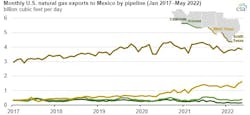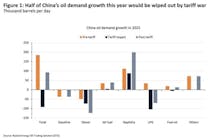EIA: US natural gas exports to Mexico increasing at West Texas border
Pipeline exports of natural gas from West Texas to Mexico averaged 1.6 bcfd in May 2022, the largest pipeline export from West Texas on record, according to the latest monthly data from the US Energy Information Administration (EIA). Pipeline exports from US West Texas increased 12% from January to May 2022 compared to 2021, averaging 1.4 bcfd.
US natural gas pipeline exports from West Texas have grown steadily in recent years, doubling to 1.2 bcfd in 2021 from 0.6 bcfd in 2019 as more connecting pipelines in central and southwest Mexico have been placed in service in the past 3 years.
Natural gas flows from the Permian basin natural gas production areas in West Texas to northwest, central, and southwest Mexico via the Chihuahua-to-Bajío corridor (including the Samalayuca-Sásabe pipeline system) and the Wahalajara system. The Wahalajara system connects the Waha Hub in West Texas to Guadalajara, Mexico’s second-most populous city. So far this year, exports from West Texas on the Samalayuca-Sásabe system have increased and displaced some US pipeline exports from Arizona, EIA said.
In Mexico, the electric power sector and (to a slightly lesser degree) the industrial sector have led natural gas consumption growth in recent years. Much of this growth has been met by growth in pipeline imports from the US.
The availability of relatively inexpensive natural gas from the US has shifted Mexico’s natural gas supply mix. The share of Mexico’s natural gas supply met by pipeline imports from the US grew to 72% in 2021 from 61% in 2019, but it has declined to 69% in the first 7 months of this year as a result of rising US natural gas spot prices, according to Wood Mackenzie.
Mexico increased its domestic natural gas production by 15% during the first 7 months of 2022 compared with the same period in 2021. The recent increase in Mexico’s domestic production was driven primarily by Quesqui and Ixachi fields, which produce a higher proportion of dry natural gas. Recent improvements in drilling rigs’ operating efficiency have also contributed to rising natural gas production.
In addition to the decline in pipeline imports, LNG imports have fallen to less than 1% so far in 2022 from over 7% of total supply in 2019.
In the first 5 months of this year, US natural gas pipeline exports from West Texas increased 12%, but exports from other US regions declined compared with year-ago levels. Exports from South Texas decreased by 5% to average 3.8 bcfd, and combined exports from Arizona and California declined by 24% to average 0.5 bcfd. Total US natural gas pipeline exports to Mexico have declined by 4% to average 5.7 bcfd over the same period.


